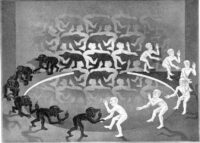I grew up with All-American images of clean-cut baseball heroes — Mickey Mantle, Whitey Ford and the like. Despite later revelations of alcohol problems, their images as wholesome, talented sportsmen resonated across the 1950s and contributed to the backdrop of conformist cultural forms against which a great number of us rebelled in the following decade.
Watching baseball today, I wonder what message America’s youth will take with them into their young lives, and how it will emerge in later life. Today’s baseball players, for all the millions many are paid, appear anything but wholesome. In fact, if I were to describe in general terms the crew of man-boys taking the field I’d have to resort to references about scary-looking tattooed biker-dudes and unshaven mohawk-headed spitting experts. Such is the look of our all-American game.
In one sense today’s baseball reflects the reality of America. What once was an all-white, working-class sport has taken on the image of a global diversity of cultural forms, and the sports fan seems to be just fine with it. Take Giants player Pablo Sandoval, affectionately known as the “Panda.” Towards the end of this season, he was sporting a Mohawk tinged with blonde highlights, but the most interesting thing about him, aside from his bulk and athletic ability, was his fetishistic rituals. A native Venezuelan, Panda’s obsession with ritual included using the small end of the bat to draw a six-pointed star with a dot in the center into the dirt next to home plate upon coming to bat. At one game I attended, as he approached the dugout he removed his cap and spoke into it, drawing figures with his index finger.
At another point in the spectrum is pitcher Brian Wilson. Wilson, a former Giant but now a Dodger, sports a black-dyed full beard tied at the bottom with a blue “stretchy” and shaved head Mohawk. I haven’t seen any ritualistic practices, just the straight-out intimidation of a “closer.” Between these two extremes is a wide range of colors, languages, ages, styles and talents. Teams have translators on staff who accompany the pitching coach to the mound for pep-talks in Korean, Japanese, and Spanish.
Truth is, baseball’s common language is spit. Nowhere else in American life does spitting seem to play such an important and visible role. Time was, male spit fueled an industry of spittoon makers, and spittoons were a regular feature in bars and joints patronized by men. On the ball field, in the dugout, on the mound, behind the plate; the cascade of spit stretches all nine innings.
The end of the spittoon arrived when women were allowed in bars, and I expect that if women sat as coaches in the dugout or stood behind the plate as umpires, the great ballpark spitting contest would quickly come to an end.
With its team names, chants, cheers, colors and symbols, baseball is inherently tribal. Fans and players come together in celebratory mock warfare, basking in both the unity of play and the energetic uncertainty of outcomes. This tribal character mirrors an emerging global tribalism, an interconnectedness of mass gatherings, social media and communications technology. What we used to think of as the all-American sport now portrays the international, multicultural, web-based reality of the 21st century.
“Purei Boru! Jueguen Bola! Nol-i Gong! Play ball!”




